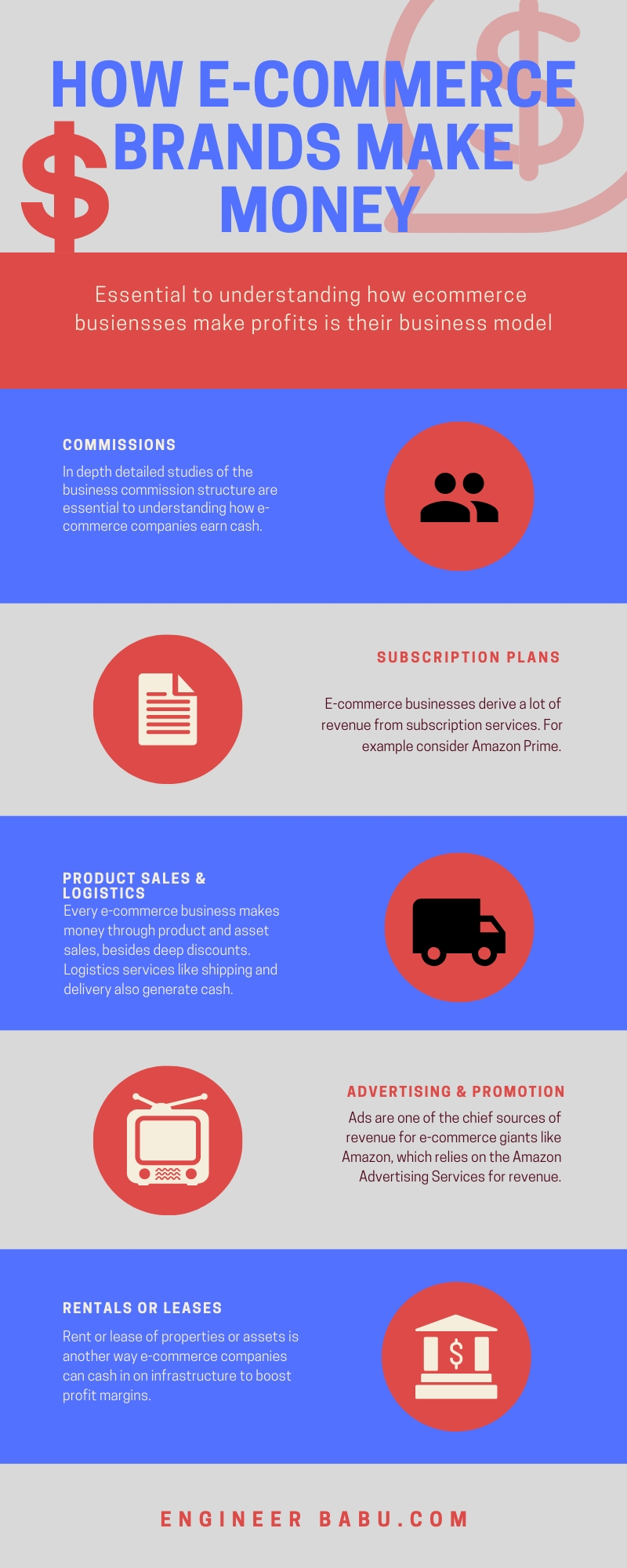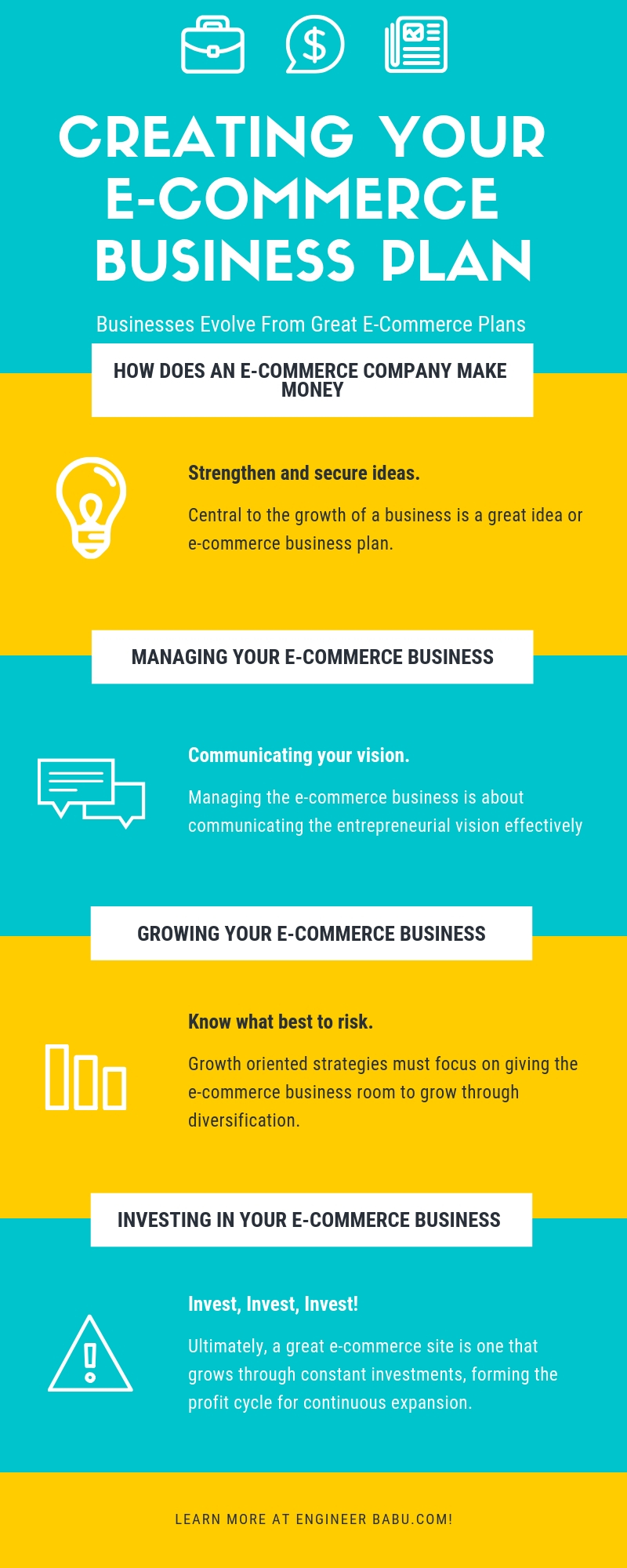Amazon is the e-commerce titan the industry has been waiting for. Net sales have been rising since 2014. In 2016, Amazon grabbed 70% of the total sales, and service sales have only been growing since then. For all those wondering is ecommerce profitable, the answer lies in Amazon’s undeniable success, so much as that the “Amazon Effect” has even entered the lexicon of industry analysts.
In terms of operating income, growth has been driven by high margins from service sales. Revenue sources, AWS services and Amazon Prime subscriptions have been rising at phenomenal rates, too.
A revenue generation model is a critical component of the ecommerce business plan. Anybody looking to understand how to start a successful ecommerce business needs to understand that making money is the key to thriving and not just surviving. The ecommerce business model unlocks value and is the key driver of value. It makes all the difference between a unicorn and a failed startup. Scaling up to a billion dollar value is a dream come true for many ecommerce businesses. For understanding how to do ecommerce businesses make money, business models offer further clarity.
Getting Into the Unicorn Circle
Whether it’s through commissions, asset sales, subscription plans, ads, usage fees, licensing and rent or lease, getting into the unicorn circle is not just about following a model. Ecommerce businesses like Amazon don’t follow one model. They follow many in a hybrid way, unlocking value in the long term. Here’s what drives ecommerce money-making ventures:

#1 Fixed Subscriptions
Registered sellers can host products on the ecommerce platform for a fixed rate of subscription. Fixed closing fees may also be charged by the ecommerce company.
#2 Commissions
Based on the product category, the company charges registered sellers certain percentage commission based on the value of the product sold. This commission generally ranges from 5 to 20%.
#3 Logistics
Logistics and shipping are addition sources of revenue for ecommerce companies. The ecommerce brands like Flipkart, Amazon, Snapdeal, Myntra or even Jabong earn delivery and shipping fees.
Trustable Ecommerce App Development Companies
#4 Deep Discounting
Justification for deep discounting of products for online retailers is that discounts are being offered, in turn, by the registered seller. The benefits of deep discounting benefit every ecommerce business from Flipkart and Amazon to Snapdeal and Myntra. The ecommerce brands come equipped with cutting-edge analytics capabilities and dedicated resources for comparing prices of products across stores and websites. Based on the price-linked research, registered sellers can then peg their price. Further, sellers get compensated for discounts offered by online retailers, leading to a win-win outcome, besides a level playing field for even the smallest ecommerce seller.
Online shopping remains at the core of successful ecommerce businesses, which essentially focus on buying and selling of goods or services online. Given that ecommerce is the fastest growing retail market, estimated to reach USD 4 trillion in sales by 2020, the question “is ecommerce profitable?” is just an empty one!
#5 Finding the Right Niche
Before they build their online stores, these ecommerce businesses focus on what to sell and how to source it. Finding a successful niche is the key to mastering the markets. Keeping a finger on the social media pulse can also make sure your ecommerce business is heads and shoulders above competitors. Suggested products, reviews and YouTube videos can prove to be valuable for researching which niches to concentrate on.
#6 Tapping Social Media
Once the store is up and running, all you need to know is spread the word. For this, social media remains a powerful marketing tool. Leading ecommerce brands like Amazon and even niche sellers have their own Facebook business page. Cashing in on Instagram influencers is another key to successful ecommerce growth.
#7 Targeting the Right Audience
Leading ecommerce retailers target the right customers. For example, if the ecommerce business is selling fitness watches, the focus is on active people who visit the gym regularly. If diet formulas are being sold, your target is those trying to lose weight.
#8 Reinvesting Profits
As the business scales and demand grows, reinvesting profits makes sense. After all, ecommerce businesses will only sustain the growth momentum if they put money back into the business to cater to a new influx of customers.
#9 Using Marketing Collateral To Drive Traffic
The hardest part of an ecommerce business is the generation of traffic, whereby most online retailers rely on exceptional marketing collateral to cut through the noise and build a powerful voice and brand narrative that resonated with customers. An effective inbound marketing campaign drives growth. Content marketing by these ecommerce giants focuses on the customer research journey and addresses the client’s pain points.
#10 Set Up Targeted Ads
Another way ecommerce businesses make money vital to their long-term growth is through targeted ads that aim for customers and profitable niches right from the start. Using product specific ads has helped ecommerce companies to grow. Remarketing ads have also served as catalysts for the growth momentum.
#11 Using Multichannel Product Distribution Methods
Ecommerce businesses need to be in more than one location online to propel growth. Growing the ecommerce business commences with diversification, backed by clear channels of distribution is the key. Whether it’s Amazon, or eBay, Walmart, Rakuten among others, companies that focus on optimizing and listing products on multiple channels win hands down. They also have registered trademarks and warranty when products are sold through authorized resellers. Clear distribution agreements also are in place with retailers and distributors regarding what they can and cannot sell including quality control, measures and anti-diversion. This remains an awesome strategy for growing your ecommerce brand.
#12 Automate Processes
The more ecommerce processes are automated, the faster and easier it is to grow for the business. Setting up systems can be time consuming, but it’s well worth the effort. From order fulfillment to accounting and marketing, automation can make a huge difference to efficiency, bottom lines and profit margins for any ecommerce startup. For instance, sales data are automated from the ecommerce cart onto accounting software. Email follow-ups are also automated based on customer behavior and profiles. The more automated processes and systems are, the more ecommerce entrepreneurs can focus on high value growth activities for their business.
#13 Invest in Search Marketing
Organic reach notwithstanding, platforms like Amazon rank products as well. So online retailers need to be clear on search marketing strategies relating to the store and industry keywords. Software tools, case studies, reports, metrics and data are equally essential.

Case Study 1: Flipkart
B2C ecommerce company Flipkart offers sale of products through multiple channels, such as websites, apps(mobile and web), tele sales, affiliate networks and social buying. Percentage commission depends on product and sale type. It can range across 5-20% depending on taxes and discounts as well. Flipkart is a Singapore registered company with Indian subsidiaries to carry out diversification and derisk the revenue model from competitors. The web portal is the prime source of income. There are listing fees and convenience fees levied alongside as well as shipping and delivery charges.
Flipkart operates its own payment gateway, logisitcs, digital media and wholesale division. It also competes in the fashion category through companies like Myntra. Phone Pe is its mobile payment interface which directly competes with Paytm and other mobile payment apps.
Flipkart also sells co-branded banner opportunities on its home page, besides targeted search results and physical products on an online platform, deriving ad revenue from this. Flipkart’s enormous user base, daily visits, page views offer incredible returns. A case in point is Flipkart’s partnership with Xiaomi in India.
Case Study 2: Amazon
Driven by Jeff Bezos’s vision, a customer-centered focus is the defining strength and USP of Amazon. Amazon identifies strong trends to embrace these. Consider its focus on AI and machine learning to accelerate business growth. As per Similar Web estimates, Amazon notches 2.7 billion visits per day in the US alone. On an average, people spend more than 6 minutes on the site and look through as many as 9 pages to purchase what they want! Amazon is the 4th most popular ecommerce site in the United States.
The focus for Amazon is on selection, price, convenience, and by extension customers. The website is designed to allow easy access. Amazon is also a manufacturer on the side, selling electronic devices like Kindle e-readers and Fire tablets. Deep discounts, free shipping courtesy Amazon Prime and a host of customer-focused initiatives make Amazon an exceptional ecommerce player.
It also offers programs that enable sellers to grow their business, sell products on their sites and their branded websites and fulfill orders through Amazon. For its seller programs, Amazon earns fixed percentage fees among other types of compensation.
Amazon also serves developers and enterprises of different sizes through its AWS or warehousing system. Broad set of global compute, storage, database and service offerings are available.
Through its Publishing service, the ecommerce business model it follows lets authors and publishers choose a 70% royalty option and make books available through Kindle and Amazon Publishing. App developers, musicians, filmmakers further publish and sell content on Amazon.
In a nutshell, Amazon works to generate value for several stakeholders.
How Does Amazon make Money?
Amazon makes most of its revenue from product sales. Products have high costs, so margins Amazon makes on them are thin. Their operating income is powered by services like AWS, Amazon Prime and seller services. Amazon’s business model derives its profits from Amazon Advertising, Amazon Prime, Amazon AWS which run with higher margins. The online stores are a foundation for further growth.
Amazon collects payments from customers fast, then paying vendors with longer payment terms. The short term liquidity is used by the ecommerce giant to invest back to speed up its growth. Through this, Amazon has become a disruptive force, offering agility for the entire industry.
The Numbers
Amazon has doubled ad revenues from the first 9 months of 2017 as against 2018. Revenues went up from USD 2.92 billion in 2017 to USD 6.72 billion in 2018. Compared to Facebook’s USD 38.37 billion and Google’s more impressive USD 83.68 billion, Amazon is still an emerging player. But given that it runs a diversified ecommerce business, with several revenue streams, Amazon has donned many avatars. It’s mantra for success is its ad business which netted USD 6 billion in revenue in the first few months of 2018 alone, besides its impressive infrastructure. Amazon Prime remains a powerful business catalyst as does Amazon AWS, the latter being worth USD 17 billion in 2017.
The Bottom Line
Affiliate links, online ads and sponsorships can bring in revenue. But building an entire business with diverse sources of revenue in the ecommerce industry requires innovation. Ecommerce is a common business model for online retailers and companies to make money. As long as margins are managed and processes are scaled up, these businesses thrive and flourish.
Concluding Thoughts
Jeff Bezos, who founded Amazon, is quoted as saying his online behemoth strives to be “an ecommerce destination where customers can find and discover anything.” At a larger scale, technology is the answer as margins will grow, when ecommerce prices come down, instead of shooting up. Companies that scale besides offering deep discounts in the long run are succeeding in the ecommerce industry. That is the secret sauce behind their growth and the recipe for their success!

